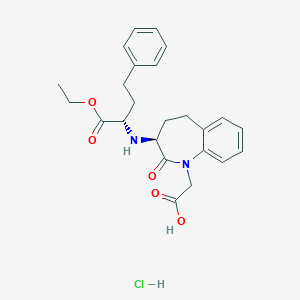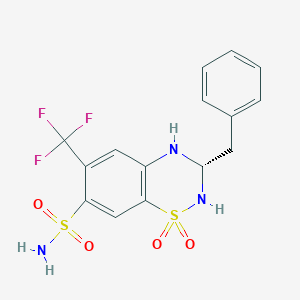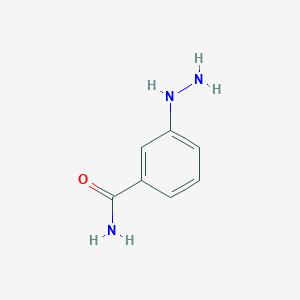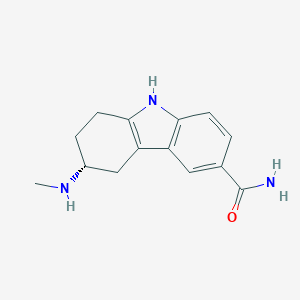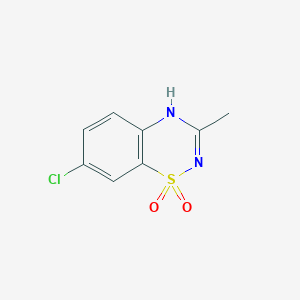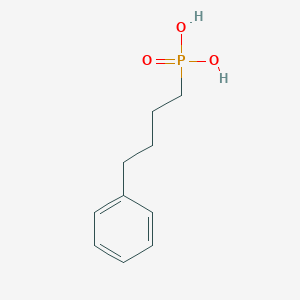
Abiraterone
Overview
Description
Abiraterone is a potent antiandrogen used primarily in the treatment of metastatic castration-resistant prostate cancer and metastatic high-risk castration-sensitive prostate cancer . It is a selective inhibitor of the enzyme 17α-hydroxylase/C17,20-lyase (CYP17), which plays a crucial role in androgen biosynthesis . This compound is often administered in the form of its prodrug, this compound acetate, to enhance its stability and absorption .
Mechanism of Action
Target of Action
Abiraterone primarily targets the enzyme 17 α-hydroxylase/C17,20-lyase (CYP17) . This enzyme is expressed in testicular, adrenal, and prostatic tumor tissues and plays a crucial role in regulating androgen biosynthesis .
Mode of Action
This compound is a potent, irreversible, and selective inhibitor of CYP17 . By inhibiting this enzyme, this compound suppresses the production of androgens, including testosterone, which are essential for the growth of prostate cancer cells . This leads to a decrease in tumor testosterone and dihydrotestosterone levels .
Biochemical Pathways
The inhibition of CYP17 by this compound affects the androgen synthesis pathway . Specifically, it suppresses the hydroxylation of pregnenolone and progesterone at C17, which limits the subsequent conversion of these hydroxylated metabolites to dehydroepiandrosterone (DHEA) and androstenedione . This results in decreased production of androgens, thereby slowing down the growth of prostate tumors .
Pharmacokinetics
This compound has poor oral bioavailability and is susceptible to hydrolysis by esterases . To overcome this, this compound acetate, an orally bioavailable prodrug with enhanced stability and absorption, was developed . Once in the body, this compound acetate is converted to this compound . The maximum plasma concentration of this compound under fasting conditions is 27.02 ± 14.21 ng/mL, and its elimination half-life is between 12–24 hours . It is primarily excreted in feces (88%) and urine (5%) .
Result of Action
The inhibition of androgen production by this compound leads to a decrease in the growth of prostate cancer cells . This is because androgens, such as testosterone, stimulate the growth of prostate cancer cells. Therefore, by reducing androgen levels, this compound slows down the progression of the disease .
Action Environment
The action of this compound can be influenced by various environmental factors. For instance, the gut microbiota plays a role in the metabolism of this compound, leading to the formation of specific metabolites . Additionally, hepatic transporters such as OATP1B3 can affect the systemic exposure of this compound, thereby influencing its pharmacokinetics and pharmacodynamics .
Biochemical Analysis
Biochemical Properties
Abiraterone plays a significant role in biochemical reactions as it selectively and irreversibly inhibits CYP17 (17 alpha-hydroxylase/C17,20-lyase), an enzyme required for androgen biosynthesis . This enzyme is expressed in testicular, adrenal, and prostatic tumor tissues . The inhibition of CYP17 by this compound leads to a decrease in the formation of the testosterone precursors dehydroepiandrosterone (DHEA) and androstenedione .
Cellular Effects
This compound has profound effects on various types of cells, particularly cancer cells. By inhibiting androgen synthesis, this compound reduces the availability of androgens, which are essential for the growth and survival of prostate cancer cells . This influences cell function, including impacts on cell signaling pathways, gene expression, and cellular metabolism .
Molecular Mechanism
The molecular mechanism of action of this compound involves its binding to the CYP17 enzyme, thereby inhibiting its activity . This prevents the conversion of pregnenolone and progesterone to DHEA and androstenedione, respectively . As a result, the levels of these androgens are reduced, leading to decreased stimulation of androgen receptors and changes in gene expression in prostate cancer cells .
Temporal Effects in Laboratory Settings
In laboratory settings, the effects of this compound have been observed to change over time . The pharmacokinetics of this compound have been studied in healthy volunteers, with results indicating that the maximum plasma concentration was achieved under fasting conditions .
Dosage Effects in Animal Models
The effects of this compound in animal models vary with different dosages
Metabolic Pathways
This compound is involved in the metabolic pathway of androgen biosynthesis . It interacts with the CYP17 enzyme, which is a key enzyme in this pathway .
Preparation Methods
Synthetic Routes and Reaction Conditions: The synthesis of abiraterone acetate typically involves a four-step process starting from dehydroepiandrosterone . The key steps include:
Condensation: Dehydroepiandrosterone is condensed with hydrazine hydrate in ethanol using sulfuric acid as a catalyst to form a hydrazone intermediate.
Iodination: The intermediate is treated with iodine in the presence of 1,1,3,3-tetramethylguanidine to yield 17-iodoandrosta-5,16-dien-3β-ol.
Suzuki Coupling: The iodinated compound undergoes Suzuki cross-coupling with 3-(diethylboryl)pyridine using a palladium catalyst to form this compound.
Acetylation: Finally, this compound is acetylated to produce this compound acetate.
Industrial Production Methods: Industrial production of this compound acetate involves similar synthetic routes but optimized for large-scale manufacturing. Techniques such as solvent evaporation, direct compaction, and melt granulation are employed to enhance the bioavailability and stability of the final product .
Chemical Reactions Analysis
Types of Reactions: Abiraterone undergoes various chemical reactions, including:
Oxidation: this compound can be oxidized to form hydroxylated derivatives.
Reduction: Reduction reactions can convert this compound to its corresponding alcohols.
Substitution: This compound can participate in substitution reactions, particularly in the presence of halogens.
Common Reagents and Conditions:
Oxidation: Reagents such as potassium permanganate or chromium trioxide are commonly used.
Reduction: Sodium borohydride or lithium aluminum hydride are typical reducing agents.
Substitution: Halogenating agents like iodine or bromine are used under mild conditions.
Major Products: The major products formed from these reactions include hydroxylated this compound, reduced this compound derivatives, and halogenated this compound compounds .
Scientific Research Applications
Abiraterone has a wide range of scientific research applications:
Chemistry: It is used as a model compound for studying steroidal enzyme inhibitors.
Biology: this compound is employed in research on androgen biosynthesis and its inhibition.
Industry: This compound acetate formulations are developed to improve bioavailability and patient compliance.
Comparison with Similar Compounds
Uniqueness of this compound: this compound’s uniqueness lies in its mechanism of action. It inhibits androgen biosynthesis at the enzymatic level, whereas other compounds like bicalutamide and enzalutamide act at the receptor level . This makes this compound particularly effective in cases where androgen receptor signaling inhibitors are less effective.
Properties
IUPAC Name |
(3S,8R,9S,10R,13S,14S)-10,13-dimethyl-17-pyridin-3-yl-2,3,4,7,8,9,11,12,14,15-decahydro-1H-cyclopenta[a]phenanthren-3-ol | |
|---|---|---|
| Source | PubChem | |
| URL | https://pubchem.ncbi.nlm.nih.gov | |
| Description | Data deposited in or computed by PubChem | |
InChI |
InChI=1S/C24H31NO/c1-23-11-9-18(26)14-17(23)5-6-19-21-8-7-20(16-4-3-13-25-15-16)24(21,2)12-10-22(19)23/h3-5,7,13,15,18-19,21-22,26H,6,8-12,14H2,1-2H3/t18-,19-,21-,22-,23-,24+/m0/s1 | |
| Source | PubChem | |
| URL | https://pubchem.ncbi.nlm.nih.gov | |
| Description | Data deposited in or computed by PubChem | |
InChI Key |
GZOSMCIZMLWJML-VJLLXTKPSA-N | |
| Source | PubChem | |
| URL | https://pubchem.ncbi.nlm.nih.gov | |
| Description | Data deposited in or computed by PubChem | |
Canonical SMILES |
CC12CCC(CC1=CCC3C2CCC4(C3CC=C4C5=CN=CC=C5)C)O | |
| Source | PubChem | |
| URL | https://pubchem.ncbi.nlm.nih.gov | |
| Description | Data deposited in or computed by PubChem | |
Isomeric SMILES |
C[C@]12CC[C@@H](CC1=CC[C@@H]3[C@@H]2CC[C@]4([C@H]3CC=C4C5=CN=CC=C5)C)O | |
| Source | PubChem | |
| URL | https://pubchem.ncbi.nlm.nih.gov | |
| Description | Data deposited in or computed by PubChem | |
Molecular Formula |
C24H31NO | |
| Source | PubChem | |
| URL | https://pubchem.ncbi.nlm.nih.gov | |
| Description | Data deposited in or computed by PubChem | |
DSSTOX Substance ID |
DTXSID80879993 | |
| Record name | Abiraterone | |
| Source | EPA DSSTox | |
| URL | https://comptox.epa.gov/dashboard/DTXSID80879993 | |
| Description | DSSTox provides a high quality public chemistry resource for supporting improved predictive toxicology. | |
Molecular Weight |
349.5 g/mol | |
| Source | PubChem | |
| URL | https://pubchem.ncbi.nlm.nih.gov | |
| Description | Data deposited in or computed by PubChem | |
Mechanism of Action |
Abiraterone is an orally active inhibitor of the steroidal enzyme CYP17A1 (17 alpha-hydroxylase/C17,20 lyase). It inhibits CYP17A1 in a selective and irreversible manner via covalent binding mechanism. CYP17A1 is an enzyme that catalyzes the biosynthesis of androgen and is highly expressed in testicular, adrenal, and prostatic tumor tissue. More specifically, abiraterone inhibits the conversion of 17-hydroxyprognenolone to dehydroepiandrosterone (DHEA) by the enzyme CYP17A1 to decrease serum levels of testosterone and other androgens. | |
| Record name | Abiraterone | |
| Source | DrugBank | |
| URL | https://www.drugbank.ca/drugs/DB05812 | |
| Description | The DrugBank database is a unique bioinformatics and cheminformatics resource that combines detailed drug (i.e. chemical, pharmacological and pharmaceutical) data with comprehensive drug target (i.e. sequence, structure, and pathway) information. | |
| Explanation | Creative Common's Attribution-NonCommercial 4.0 International License (http://creativecommons.org/licenses/by-nc/4.0/legalcode) | |
CAS No. |
154229-19-3 | |
| Record name | Abiraterone | |
| Source | CAS Common Chemistry | |
| URL | https://commonchemistry.cas.org/detail?cas_rn=154229-19-3 | |
| Description | CAS Common Chemistry is an open community resource for accessing chemical information. Nearly 500,000 chemical substances from CAS REGISTRY cover areas of community interest, including common and frequently regulated chemicals, and those relevant to high school and undergraduate chemistry classes. This chemical information, curated by our expert scientists, is provided in alignment with our mission as a division of the American Chemical Society. | |
| Explanation | The data from CAS Common Chemistry is provided under a CC-BY-NC 4.0 license, unless otherwise stated. | |
| Record name | Abiraterone [INN:BAN] | |
| Source | ChemIDplus | |
| URL | https://pubchem.ncbi.nlm.nih.gov/substance/?source=chemidplus&sourceid=0154229193 | |
| Description | ChemIDplus is a free, web search system that provides access to the structure and nomenclature authority files used for the identification of chemical substances cited in National Library of Medicine (NLM) databases, including the TOXNET system. | |
| Record name | Abiraterone | |
| Source | DrugBank | |
| URL | https://www.drugbank.ca/drugs/DB05812 | |
| Description | The DrugBank database is a unique bioinformatics and cheminformatics resource that combines detailed drug (i.e. chemical, pharmacological and pharmaceutical) data with comprehensive drug target (i.e. sequence, structure, and pathway) information. | |
| Explanation | Creative Common's Attribution-NonCommercial 4.0 International License (http://creativecommons.org/licenses/by-nc/4.0/legalcode) | |
| Record name | Abiraterone | |
| Source | EPA DSSTox | |
| URL | https://comptox.epa.gov/dashboard/DTXSID80879993 | |
| Description | DSSTox provides a high quality public chemistry resource for supporting improved predictive toxicology. | |
| Record name | (1S,2R,5S,10R,11S,15S)-2,15-dimethyl-14-(pyridin-3-yl)tetracyclo[8.7.0.0²,�.0¹¹,¹�] heptadeca-7,13-dien-5-ol | |
| Source | European Chemicals Agency (ECHA) | |
| URL | https://echa.europa.eu/information-on-chemicals | |
| Description | The European Chemicals Agency (ECHA) is an agency of the European Union which is the driving force among regulatory authorities in implementing the EU's groundbreaking chemicals legislation for the benefit of human health and the environment as well as for innovation and competitiveness. | |
| Explanation | Use of the information, documents and data from the ECHA website is subject to the terms and conditions of this Legal Notice, and subject to other binding limitations provided for under applicable law, the information, documents and data made available on the ECHA website may be reproduced, distributed and/or used, totally or in part, for non-commercial purposes provided that ECHA is acknowledged as the source: "Source: European Chemicals Agency, http://echa.europa.eu/". Such acknowledgement must be included in each copy of the material. ECHA permits and encourages organisations and individuals to create links to the ECHA website under the following cumulative conditions: Links can only be made to webpages that provide a link to the Legal Notice page. | |
| Record name | ABIRATERONE | |
| Source | FDA Global Substance Registration System (GSRS) | |
| URL | https://gsrs.ncats.nih.gov/ginas/app/beta/substances/G819A456D0 | |
| Description | The FDA Global Substance Registration System (GSRS) enables the efficient and accurate exchange of information on what substances are in regulated products. Instead of relying on names, which vary across regulatory domains, countries, and regions, the GSRS knowledge base makes it possible for substances to be defined by standardized, scientific descriptions. | |
| Explanation | Unless otherwise noted, the contents of the FDA website (www.fda.gov), both text and graphics, are not copyrighted. They are in the public domain and may be republished, reprinted and otherwise used freely by anyone without the need to obtain permission from FDA. Credit to the U.S. Food and Drug Administration as the source is appreciated but not required. | |
Retrosynthesis Analysis
AI-Powered Synthesis Planning: Our tool employs the Template_relevance Pistachio, Template_relevance Bkms_metabolic, Template_relevance Pistachio_ringbreaker, Template_relevance Reaxys, Template_relevance Reaxys_biocatalysis model, leveraging a vast database of chemical reactions to predict feasible synthetic routes.
One-Step Synthesis Focus: Specifically designed for one-step synthesis, it provides concise and direct routes for your target compounds, streamlining the synthesis process.
Accurate Predictions: Utilizing the extensive PISTACHIO, BKMS_METABOLIC, PISTACHIO_RINGBREAKER, REAXYS, REAXYS_BIOCATALYSIS database, our tool offers high-accuracy predictions, reflecting the latest in chemical research and data.
Strategy Settings
| Precursor scoring | Relevance Heuristic |
|---|---|
| Min. plausibility | 0.01 |
| Model | Template_relevance |
| Template Set | Pistachio/Bkms_metabolic/Pistachio_ringbreaker/Reaxys/Reaxys_biocatalysis |
| Top-N result to add to graph | 6 |
Feasible Synthetic Routes
Disclaimer and Information on In-Vitro Research Products
Please be aware that all articles and product information presented on BenchChem are intended solely for informational purposes. The products available for purchase on BenchChem are specifically designed for in-vitro studies, which are conducted outside of living organisms. In-vitro studies, derived from the Latin term "in glass," involve experiments performed in controlled laboratory settings using cells or tissues. It is important to note that these products are not categorized as medicines or drugs, and they have not received approval from the FDA for the prevention, treatment, or cure of any medical condition, ailment, or disease. We must emphasize that any form of bodily introduction of these products into humans or animals is strictly prohibited by law. It is essential to adhere to these guidelines to ensure compliance with legal and ethical standards in research and experimentation.


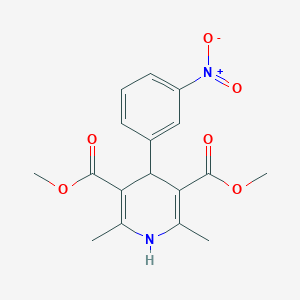
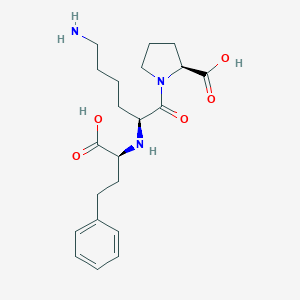

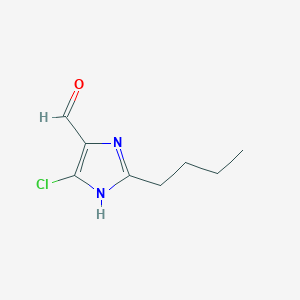
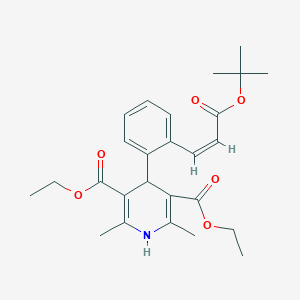
![2-[4-[[2-Butyl-4-chloro-5-(hydroxymethyl)imidazol-1-yl]methyl]phenyl]benzonitrile](/img/structure/B193149.png)
![Des[2'-(1H-tetrazol-5-yl)] 2-Cyanolosartan Carboxaldehyde](/img/structure/B193153.png)
![5-(4'-Methyl-[1,1'-biphenyl]-2-yl)-1-trityl-1H-tetrazole](/img/structure/B193154.png)
